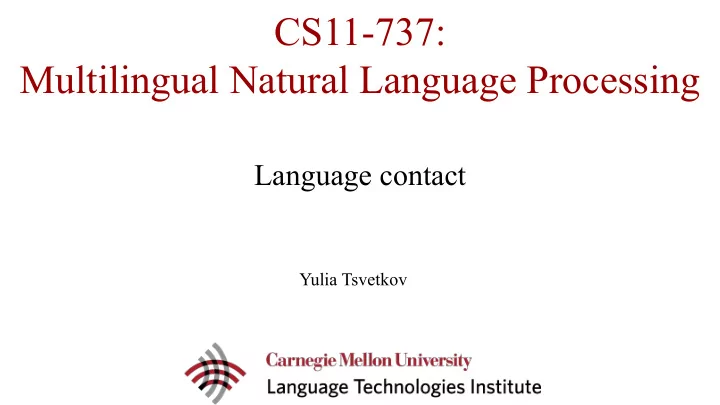

CS11-737: Multilingual Natural Language Processing Language contact Yulia Tsvetkov
Language contact ● Language contact is the use of more than one language in the same place at the same time (Thomason ‘95)
Language contact drives language change Factors driving the change of languages and language varieties: ● Language-internal ○ ease of articulation ○ analogy/reinterpretation ○ language contact ● Language-external ○ language contact ○ geography ○ social prestige ■ conscious ■ subconscious
Arabic--Swahili ● 800 A.D.-1920 Indian Ocean trading ● Influence of Islam ● ~40% of Swahili types are borrowed from Arabic (Johnson ‘39)
Lexical borrowing is pervasive in languages
Cross-lingual lexical similarities ● How to bridge across languages? ● Identify words that are orthographically or phonetically similar across different languages and are likely to be mutual translations
Mapping lexicons across languages
Cross-lingual lexicon induction
Lexicon structure ● Core-periphery lexicon structure (Itô & Mester ‘95) ● English: ○ Core (20%–33%): beer, bread ○ Assimilated: cookie, sugar, coffee, orange ○ Peripheral: New York, Luxembourg
How to bridge across languages?
Transliteration models ● FSTs Knight & Graehl ‘98 ● Noisy channel approaches Al-Onaizan & Knight ‘02, Virga & Khudanpur ‘03 ● String similarity and temporal similarity of distributions in comparable corpora Klementiev & Roth ‘06 ● Phonetic similarity and temporal similarity of distributions Tao et al. ‘06 ● Decipherment approaches to phonetic mapping in non-parallel corpora Ravi & Knight ‘09 ● CRFs Ganesh et al.’08, Ammar et al. ‘12
Transliteration ● LSTMs with attention Rosca & Breuel’16 ● Exact Hard Monotonic Attention for Character-Level Transduction Wu & Cotterell’19
Transliteration evaluation Intrinsic evaluation ● Word accuracy in top-1 ● Fuzziness in top-1 (mean F-score) ● Mean Reciprocal Rank (MRR) ● Mean Average Precision (MAP) Downstream evaluation ● Machine translation ● Cross-lingual information extraction
Transliteration resources ● 1.6M named entities across 180 languages aggregated across multiple public datasets
Cognates and loanwords
Arabic--Swahili borrowing examples English Arabic Swahili Phonological & morphological integration Semitic Bantu * syllable structure adaptation: CV, CVV, CVC, CVCC → V, CV feverﻰﻤﺣ homa * degemination - Swahili does not allow consonant clusters ḥummat * vowel substitution * Arabic morphology (optionally) drops * Swahili morphology is applied ministerﺮﯾزﻮﻟا kiuwaziri * vowel epenthesis to keep syllables open Alwzyr * vowel substitution * consonant adaptation: /tˤ/→/t/, /dˤ/→/d/, /θ/→/s/, palaceﺮﺼﻘﻟا kasiri /x/→/k/, etc AlqSr * vowel epenthesis
Linguistic research on lexical borrowing ● Case studies of lexical borrowing in language pairs ○ Cantonese (Yip ‘93), Korean (Kang ‘03), Thai (Kenstowicz & Suchato ‘06), Russian (Benson ‘59), Romanian (Friesner ‘09), Hebrew (Schwarzwald ‘98), Yoruba (Ojo ‘77), Swahili (Schadeberg ‘09), Finnish (Johnson ‘14), 40 languages (Haspelmath & Tadmor ‘09), etc. ● Case studies of phonological/morphological phenomena in borrowing ○ Phonological integration (Holden ‘76, Van Coetsem ‘88, Ahn & Iverson ‘04, Kawahara ‘08, Hock & Joseph ‘09, Calabrese & Wetzels ‘09, Kang ‘11); morphological integration (Rabeno ‘97, Repetti ‘06); syntactic integration (Whitney ‘81, Moravcsik ‘78, Myers-Scotton ‘02), etc. ● Case studies of sociolinguistic phenomena in borrowing ○ (Guy ‘90, McMahon ‘94, Sankoff ‘02, Appel & Muysken ‘05), etc.
Cognate and loanword models ● Phonologically-weighted Levenshtein distance between phonetic sequences Mann & Yarowsky ‘01, Dellert ‘18 ● Phonetic + semantic distance Kondrak ‘01, Kondrak,Marcu & Knight ‘03 ● Log-linear model with Optimality-theoretic features Bouchard-Côté et al. ‘09 ● Generative models of sound laws and word evolution for cognate identification Hall & Klein ‘10, ‘11 ● Optimality-theoretic constraint-based learning for loanword identification Tsvetkov & Dyer ‘16 ● Cognate identification using Siamese CNNs Soisalon-Soininen & Granroth-Wilding ’19
Cognate databases ● 3.1 million cognate pairs across 338 languages using 35 writing systems
Lexical borrowing databases https://wold.clld.org/
Bilingual lexicon induction ● Bilingual embeddings ● Multilingual embeddings ● Subword-based multilingual embeddings ● Subword-based multilingual embeddings with incorporated morphological and phonological knowledge ● Bilingual lexicon induction via embedding similarity https://ruder.io/cross-lingual-embeddings/
Class discussion ● Pick a language that you speak ● Read about the history of this language, and in particular how this language influenced other languages ○ are there languages that historically borrowed words from your language? ○ can you find specific examples of words? ○ could you recognize these loanwords in other languages based on their new form? ○ can you guess what were phonological and morphological adaptation processes that the loanword had to undergo to assimilate in the new language?
Recommend
More recommend